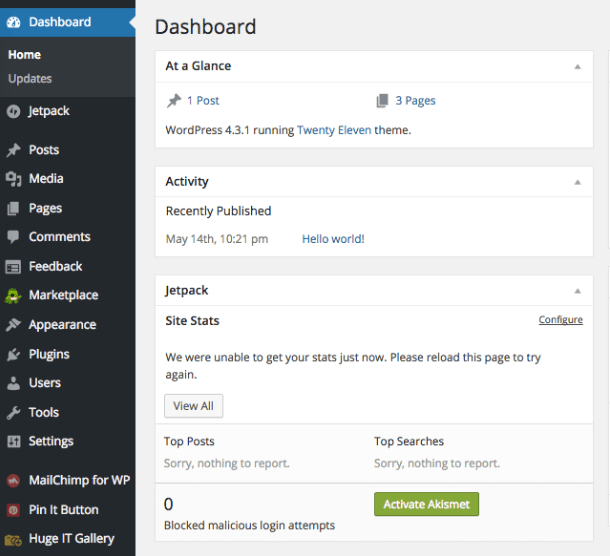
What’s the Difference between Shopify and WordPress?
Shopify is what’s known as a ‘website builder’. So to understand what Shopify is, we first need to know what a website builder is.
A website builder is an online tool that helps people with limited or no technical knowledge build their very own website. They then pay a small fee each month to the website builder platform in order to keep their site live.
Shopify is built specifically for ecommerce, so it’s only ever used for creating online stores (as opposed to blogs or online résumés).
We Recommend Shopify if
- You have limited technical knowledge and want to create your own online store
- You want to keep good track of your budget
- You value convenience
WordPress is a little different. It comes in two forms – WordPress.com and WordPress.org.
WordPress.com is a blogging platform that works in the same way as a website builder, allowing you to easily create your own website. WordPress.org is self-hosted software,and is far more technically advanced.
You can create just about any type of website with WordPress.org – including online stores – so it’s this version of WordPress that we’ll be comparing to Shopify.
We Recommend WordPress if
- You have some form of coding knowledge
- You have the budget to pay for a developer’s help
- You want total control over your site’s customization
Staggeringly, WordPress.org is the force behind almost a third of all websites on the internet. On the other hand, you have Shopify – a world-renowned ecommerce platform that’s used by major businesses and celebrities alike, and powers over 600,000 online stores in total.
Shopify is made to help people start their own online stores, meaning it has all the tools you could need right at your fingertips. Unlike Shopify, WordPress doesn’t come set up for ecommerce, but there are some great plugins you can install to start selling online – we recommend the WooCommerce plugin to turn your WordPress site into an online store.
To set up a store with Shopify, all you do is create an account, choose a theme, add your products, and you’re off. In contrast, WordPress takes a little more time. You need to find hosting first (we recommend Bluehost), then install themes and plugins to get started and customize your website.
- Want to learn more about Bluehost? Read our Bluehost Review
- Find out how much Bluehost costs using our Bluehost Pricing Review
Shopify vs WordPress: Pros and Cons
Shopify vs WordPress: Pros and Cons
| Shopify Pros | Shopify Cons |
|---|---|
|
|
| WordPress Pros | WordPress Cons |
|---|---|
|
|
How Easy Are They to Use?

The Winner
Shopify is easier to use
Coding is the biggest difference when it comes to Shopify vs WordPress. With Shopify, you can create and customize your online store without needing to know a single line of code.
You’ll start off by telling Shopify a little bit about your current position – whether you already sell online or in person and, if so, what your current revenue is.
From here, you’ll enter Shopify’s dashboard. Think of this like your control room, from which you can manage anything to do with your online store. There are even prompts and tips to help you know how and where to start.
Adding products is really simple, too. You can either add them individually – by uploading your product shots and adding descriptions, prices, and variants – or in bulk, by importing an existing CSV file with all your product information.
The interface is similar to a word document, so you shouldn’t get stuck inputting any information. And even if you do, there’s always support on hand. One of the users we spoke to said it best:
“I loved the option to add products to the collection either manually or automatically (based on conditions) – Shopify thinks one step ahead for the user.”

WordPress, on the other hand, is a little more complex. For starters, you’ll need to know how to code – even if it’s just at a basic level – to use the platform.
It’s also not naturally set up to sell online, so you will need to install a plugin to make your website ecommerce ready.
There are plenty of ecommerce plugins out there – such as WooCommerce, Ecwid, and BigCommerce – so it’s important to spend some time reading up on them before deciding which to use.
Like Shopify, WordPress has its own centralized dashboard where you can manage your website. Because WordPress is such a vast platform, it can get a little overwhelming as there are simply so many tools and options.

It’s pretty simple to create content and add products, but when it comes to customizing your site’s appearance, things can get a little tricky.
Your best bet is to either spend plenty of time learning all the tricks of the WordPress trade, or pay for a developer to help you – although they can charge eye-watering fees.
Further Information
- Looking for something super quick and easy? Our review of the 4 Easiest ADI Website Builders To Use is worth a look!
- If you’re wondering where to start, read our in-depth guide on How To Build An Online Store for a step-by-step breakdown
What's the Build Time Like with Shopify and WordPress?

The Winner
Shopify has a quicker build time
Build time is directly linked to ease of use. Naturally, the easier a platform is to use, the quicker it will be for you to set up.
Shopify is undoubtedly the quicker option when creating an online store. It’s a website builder that’s specifically designed to help you make an ecommerce website.
Shopify is not suitable if you don’t want to sell online. So if you just need a regular personal or business site – and value your time – then something like Wix or Squarespace is far better suited.
Read in more detail about Wix in our full Wix Review. Or, check out how Squarespace can help you in our detailed Squarespace Review.
WordPress offers you the chance to build both ecommerce and non-ecommerce websites. However, the set up time is longer for two main reasons:
Firstly, WordPress is far more technical and therefore harder to get your head around. Plus, you have to install extra ecommerce plugins if you want to build an online store.
Secondly, you have to set up things like web hosting and a domain name separately.
Bluehost is our top-rated hosting provider. It offers both WordPress and WooCommercehosting plans, with prices starting at just $2.95/month. Depending on which plan you choose, it will come packed with lots of helpful features, such as one-click WordPress installation, a free domain name and SSL certificate, and WooCommerce auto-install. This makes the setup process a whole lot quicker and simpler, saving you time to build and design your WordPress store.
How Much Do They Cost?

The Winner
Shopify is cheaper overall
Cost is one of the most important factors when deciding to invest in anything, and deciding between Shopify and WordPress is no different.
Shopify offers a 14-day free trial and three main plans, along with Shopify Lite (which allows you to set up a Facebook store), and Shopify Plus (an enterprise-level plan sold on a quote by quote basis).
99% of you will probably be best off with one of the three main plans, so that’s what we’ll discuss. Below, you can see a breakdown of the prices, as well as the savings you can make on each if you commit to a longer term:
| Shopify Pricing Plans | Shopify Basic | Shopify | Advanced Shopify |
|---|---|---|---|
| Monthly | $29.00 | $79.00 | $299.00 |
| 1-Year $/month |
$26.10 | $71.10 | $269.10 |
| Savings (%) | 10% | 10% | 10% |
| 2-Years $/month |
$23.20 | $63.20 | $239.20 |
| Savings (%) | 20% | 20% | 20% |
10% or 20% may not sound like a lot, but these savings can add up really quickly. For example, if you sign up to the Advanced Shopify plan, you’d save $358.80 by signing up for a year in advance, and $1,435.20 for signing up two years in advance. This is an easy saving for businesses to make if they get on well with Shopify and have a steady business. A little forward planning can mean a huge saving.

Most small merchants will find Shopify Basic perfectly adequate. You’ll receive access to all the themes, use the same editor, get 24/7 support, and have the majority of ecommerce features.
The benefit of upgrading to the Shopify plan is that, on top of all that, you’ll have a detailed reporting tool and abandoned cart recovery. Two massive bonuses to any business.
The Advanced Shopify plan again goes one step further, letting you in on advanced reporting and real-time shipping.
For us, the Shopify plan at $79/month is the best value for money. The abandoned cart recovery in itself can easily help you recoup the $50 difference in upgrade cost each month.
WordPress on the other hand is entirely free to use. Don’t be fooled, though, it’s far from free once you get up and running.
Here you can see exactly how much everything will cost you to set up, and how ‘free’ can quickly become a few hundred bucks.
| WordPress Website Hosting Costs |
Monthly Costs: anywhere between $5 – $100
|
|---|---|
| WordPress Tutorials & Courses Costs |
Monthly Costs: free to $50+
|
| WordPress Theme Costs |
One-time Cost: free to $5,000+
|
| WordPress Plugin Costs |
One-Time Cost: $50 – $500 and/or Monthly Costs: $5 – $150
|
On the upside, WordPress’ WooCommerce plugin is free to use. Ecwid also has a free plan, but you can only sell unlimited products with Ecwid Unlimited, which costs $99/month.
A good way of thinking about Shopify vs WordPress in terms of costs is through hotels.
Shopify is the all-inclusive package that seems more expensive at first, but once you’re there, everything you need is included. WordPress is initially the more budget-friendly option, until you realize you need to pay for everything, from your food and drink, to beachside sunbeds.
Templates and Theme
The Winner
It's a tie!
Templates (often referred to as themes), are the basic layout of your website. Think of them like a PowerPoint design, where you choose how your slides will look before adding in the content.
Shopify has over 70 themes for you to pick from.
10 of these themes are free, while the other 60+ start from $140. That sounds steep, but it’s a one-off investment that helps bring your website to life.
Importantly, these are all mobile responsive, meaning your site’s layout will adapt automatically to fit different screen sizes when people are browsing on their mobile or tablet.
When it comes to choice, WordPress blows Shopify out of the water. WordPress offers over 1,000 themes – and that’s just for ecommerce!
There are also plenty more themes that plugins either provide themselves, or that are made by third party developers.

Inevitably, with such a large range to pick from, some WordPress themes are better than others. Not all are mobile responsive, and the ones not designed by WordPress itself may clash with the platform when updates roll around.
For this reason, we’d recommend using one of WordPress’ own ecommerce themes. You’ll also be able to customize them to your heart’s content. If you have a sound knowledge of coding, the control over your site’s aesthetic is pretty much limitless.
Further Information
- Just how good are Shopify’s themes? Find out more in our Shopify Themes Review
- Looking for inspiration? Look no further than this example list of 24 Free Professional Ecommerce Templates To Try
Ecommerce Tools and Features

The Winner
WordPress has better features
Tools and features are the meat and bones of an ecommerce website. They’re what help you market and sell your products.
Shopify has its own in-house ecommerce tools for you to use, whereas WordPress relies on ecommerce features provided by third party plugins.
Shopify Features
Shopify allows you to sell an unlimited amount of products on any pricing plan. You can also sell both physical products, and digital downloads.
All the main marketing, shipping, inventory and analytical tools are built-in, with alternative or more advanced versions of each offered in Shopify’s app store at an additional charge.
Shopify has hundreds of ecommerce features. We’ll drill down into the top ones, and why they’re so important:
- Abandoned Cart Recovery – Set up your site to send email reminders to customers who leave your website with items in their cart before checking out.
- Discount Codes – Create unique codes that customers can use at your checkout for money off. These are also great to use in email marketing.
- Multi Channel Integration – Don’t just limit yourself to your website, sell directly across major social media platforms and global marketplaces, like Facebook and Amazon.
WordPress Features
Because each plugin offers tons of different ecommerce features, it’s impossible to say what your specific website may have. To give you a flavor of what you could expect, though, here’s what two of the most popular plugins – WooCommerce and Ecwid – offer:
WooCommerce Features
Shopify supports more than 100 different payment gateways, including all the big hitters: PayPal, Stripe, Square, Amazon Pay, and Apple Pay.
It also has its own payment gateway – Shopify Payments – which can process orders in most major currencies.
The benefit of opting for Shopify Payments is that you won’t be charged an additional transaction fee.
With the other payment gateways, you can expect charges of between 0.5% to 2% per transaction, depending on which Shopify pricing plan you sign up to.
Similar to its ecommerce features, WordPress’ payment options are provided through its plugins. WooCommerce, Ecwid and WP eCommerce all cover most major gateways, and you won’t be charged anything more on top of each one’s own transaction fee.
Below, you can see which major payment gateways are supported by each platform/plugin:
| Platforms / Plugins | Credit/Debit Cards | PayPal | Stripe | Square | Amazon Pay | Apple Pay | Own Payment Gateway |
|---|---|---|---|---|---|---|---|
| Shopify | ✔ | ✔ | ✔ | ✔ | ✔ | ✔ | ✔ |
| WooCommerce | ✔ | ✔ | ✔ | ✔ | ✔ | ✔ | X |
|
Ecwid |
✔ | ✔ | ✔ | ✔ | X | ✔ | X |
| WP eCommerce | ✔ | ✔ | ✔ | ✔ | X | X | X |
Which is better for SEO?

The Winner
Shopify has better SEO tools
Search Engine Optimization (SEO for short) is the process of increasing your website’s visibility on search engines, like Google and Bing, by tweaking certain aspects of it.
Shopify allows you to do this in a number of ways, including adding specific titles and descriptions that appear in search results for each web page (metadata), and customizing your URLs and site structure so it’s easier for search engines to understand, or ‘crawl’.
There are a whole bunch of other neat SEO features too, but we’re not going to get bogged down in that here. Instead, head over to out Shopify SEO review for a full breakdown of exactly what you can and can’t do to optimize your site.
WordPress SEO, you won’t be surprised to learn, is done through external plugins. The most popular SEO WordPress plugin is Yoast, which can either be used for free, or for $69 to get its advanced features.
Further Information
- Still worried about whether your store will rank with Shopify? Read our Shopify SEO Review for a more detailed breakdown.
- Thinking you should choose WordPress simply for its SEO? Before you do that, check out our article on Website Builder SEO vs WordPress SEO!
Marketing Tools and Features

The Winner
WordPress has better marketing tools
As an all-in-one ecommerce website builder, Shopify offers some important features to help you keep in touch with your customers, including:
- Abandoned cart recovery emails that you can customize and even add discount codes to
- Confirmation emails that you can customize for whenever a customer places an order
If you want to go the extra mile in terms of email marketing, Shopify offers integrations with some third-party tools like Campaign Monitor and Constant Contact. Shopify doesn’t integrate directly with the email marketing giant MailChimp, but if you’re dead set on using this tool, you can combine the two yourself using an integration tool like Zapier.
WordPress also relies on third-party apps for email marketing, but the selection is much wider. For example, plugins for MailChimp, GetResponse, and other powerful email marketing platforms only scratch the surface of WordPress’ seemingly endless library of third-party tools.
As far as social media integration goes, every Shopify theme comes with social media icons to help you make your profiles super accessible. Plus, you can sell across Facebook and Instagram.
However, most of Shopify’s social media integrations require you to install an app first. This is also the case with WordPress, but again, you’ll have a lot more options to choose from in the WordPress plugins store.
Performance and Security
The Winner
Shopify beats WordPress
Both Shopify and WordPress will carry out their own routine updates.
While using Shopify this will happen automatically, and won’t affect you in the slightest. However it’s something you may have to keep an eye on with WordPress.
WordPress’ main software, themes, and plugins can all update at different times, and if you’re not using a theme or plugin that is built by WordPress itself, you may lose track of things.
Think of this like paying your bills. If you live in rented accommodation and have your bills included, you don’t need to worry about the individual cost of each utility. However, bills can become harder to manage if you need to sort out your water, heating, and electricity separately.
To avoid the hassle, we recommend using a hosting provider that takes care of updates for you. Bluehost came top of our hosting research for WordPress websites, offering one-click installs and automated daily updates.
The same applies for your website’s security. With Shopify, you get an SSL certificate included in each plan which protects you and your site’s visitors data. This is yet another thing you will have to research and pay for individually with WordPress.
Customer Help and Support

The Winner
Shopify has stronger support options
Shopify’s customer help is second to none. You can receive 24/7 help in a variety of ways, including by phone, email, live chat, and via Shopify’s onsite Help Center.
On top of that, customers on the Shopify Plus plan will gain access to their very own merchant success manager, who is responsible for providing you with constant guidance.

Shopify is a popular ecommerce builder that’s designed solely for helping people create their own online stores. On the other hand is WordPress, which needs a plugin like WooCommerce to sell online, but gives you total flexibility over your store. It’s a powerful platform, especially if you have some technical know-how.
Shopify vs WordPress is a great battle between two web building heavyweights.
Shopify is an ecommerce website builder that allows you to create an online store without being a master of code.
This makes Shopify perfect for beginners and time-pressured startups, whereas WordPress takes a little more time and effort to set up. Knowing how to code is a benefit that unlocks a better level of customization, making WordPress ideal for ambitious and tech savvy sellers.
WordPress is free, but you’ll need to pay for hosting, plus any premium themes or plugins you might want to use for your store.
This makes WordPress pretty hard to budget for, as there’s no set pricing, but does mean you can control your own costs. Shopify, meanwhile, has three main price plans for you to choose from, starting at $29 per month.
To recap all the areas we’ve looked at, here’s a quick summary table:
| Area | Shopify | WordPress | Winner |
|---|---|---|---|
| Ease of Use | Easier to use, requires little to no coding knowledge. | More technical but gives you almost limitless customization. | Shopify |
| Build Time | Quick to get your store up and running with bulk product uploads and an intuitive dashboard. | Slightly lengthier process unless you’re a coding whizz. You’ll need to choose and install an ecommerce plugin. | Shopify |
| Cost | A 14-day free trial and three main pricing planswhich range from $29/month to $299/month. | Free to use but can quickly escalate to a few hundred dollars when you pay for themes, hosting, plugins, and tutorials. | Shopify |
| Themes | Over 70 themes to pick from which are all mobile responsive and designed in-house. | Thousands of themes to look through but they vary in quality. | Tie |
| Ecommerce Features | Comes with all the ecommerce features you need to sell online and scale your business. | Most of the main plugins have decent ecommerce features, but you may need to search for separate tools for things like analytics. | WordPress |
| Payment and Transactions | Over 100 different payment options and its own gateway. It does charge you its own transaction fees, though. | Depends on the plugin you use, but most support the major payment gateways with no transaction fees of their own. | Tie |
| SEO | Built-in SEO features allow you to optimize your website and improve your web page’s rankings. | You’ll need an SEO pluginand will have to pay extra to access premium features which come as standard on Shopify. | Shopify |
| Marketing | Offers some third-party integrations | Offers tons of third-party integrations | WordPress |
| Performance | Updates won’t impact on your website as everything is taken care of in-house. | Depending on the theme, hosting, and security you go for, updates may affect your site. | Shopify |
| Help and Support | 24/7 help available via phone, email and live chat. There’s also a Help Center and advanced support for Shopify Plus users. | No form of personal support, but there’s plenty of technical information in WordPress’ forums. | Shopify |
Which one you decide on ultimately comes down to your budget and skill level. For us, Shopify is the better overall platform for ecommerce websites. You have everything you need to be successful and grow, all packed into one, easy-to-use dashboard.














